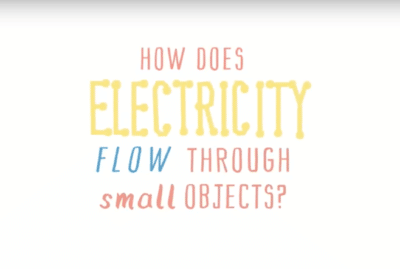Jet Plight
Saturday 14th Dec 2013, 3.45pm
Jet engines are in many ways the ultimate mechanical engineering endeavour. The flow temperatures, pressures and accelerations involved are all extreme. There is no way that poor Ossie could have survived the journey made in the animation.
Extreme engineering
Jet engines are in many ways the ultimate mechanical engineering endeavour. The flow temperatures, pressures and accelerations involved are all extreme. There is no way that poor Ossie could have survived the journey made in the animation.
At maximum thrust, for example during aeroplane take-off, the engine will be experiencing pressures of 700 psi and temperatures of 2,400 Kelvin (2,127 ºC), and the air flowing through the turbine blades will be subjected to accelerations equivalent to 50,000 times that of the gravitational acceleration on Earth.
What does that feel like?
To get some idea of how this feels, imagine swimming underwater. At just 10 metres deep, your body experiences a pressure of around 30 psi. Even at these relatively low pressures, you can already feel it affecting your eardrums. To reach 700 psi you would need to be 480 metres deep. This pressure is pushing on all parts of your body at once with the equivalent of a horse stood on an area the size of your thumb.
As for the temperatures… well, molten lava is comparatively cool at around 2,000 Kelvin or 1727 ºC.
Finally, high-performance cars only produce around 2-5 g and the average person can only withstand 5-10 g as a sustained acceleration.
Not surprisingly, this combination of conditions isn’t found in many places on Earth and they’re not recreated in the lab. Instead, computers are used to run simulations as the engine is designed.
How do engines run hotter than the metal’s melting point?
Certain points of the engine can operate with gas temperatures much higher than the melting point of the parts they’re made of. Some very clever engineering goes into keeping the components cool so the engine can continue to run.
When jet engines were first developed, many turbine parts were not cooled. These days, air is used as the coolant. Vast amounts of air are drawn in at the front of an engine, and complicated sets of rotating and stationary aerofoils are used to compress and then expand the air. An intricate network of internal ducts directs the air around the parts that need to be protected from overheating. Individual turbine blades often have a network of cooling holes inside them, to stop them melting.
Does each blade actually need the force of a bus to keep it moving?
Imagine you are whirling an object around your head on a piece of string. The force you can feel along the string is known as the centripetal force. This force keeps the object accelerating towards the centre of the circle, near to your head.
Inside a modern jet engine, the compressor and turbine blades can be rotating at up to 12,000 rpm – this generates very high forces. The force of the blade is a function of its mass, the radius through which it’s orbiting and the speed at which the whole disc of blades is moving. For some turbine blades, these figures add up to create a force equivalent to the weight of a double-decker bus.
How do you make engines more efficient?
There are lots of ways that engines can be made more efficient, but the most significant advances can be made in the following ways:
In modern turbofan engines, such as those used for civil airliners, lots of air is drawn through by the fan. Some of this air goes through the core, where it’s compressed and heated before being ignited to create power. The rest of the air passes around the core and avoids the combustion chamber. The amount of air by-passing the core divided by the amount of air passing through the core is known as the bypass ratio and, for modern turbofans, is typically around 10:1. By increasing the ratio of by-pass air to core air, an engine’s efficiency can be improved.
The temperatures and pressures that engines operate at are also important in efficiency – the higher they both are, the better. But increasing conditions lead to knock-on issues with such as the need to use engineering materials that can cope and the requirement for more cooling air.
Finally, careful engineering of the engine will reduce losses in efficiency that are brought about through leaks and less than ideal aerodynamic performance. A combination of computer models and experimental simulation strategies is used to determine the effect of design changes.
How can you test something that runs at such extremes?
The whole engine design is carried out by engineers using computers. Complex codes are used to predict stresses and what will happen to the air flows. A huge amount of work goes into developing these codes. But in some parts of the engine, the physics of the air flow is so complicated that computers can’t yet accurately simulate what happens. In these cases, physical tests are carried out. This combination of computer simulation, experiments and component tests allows engineers to design engines that use flows that are much more complicated than can be understood using theory alone.
Oxford University is home to some of this test equipment, including:
The Oxford Turbine Research Facility – this measures aerodynamic loss, turbine efficiency and surface heat transfer in the turbine stage of the engine.
A Capacity Test Facility – this is used to measure the capacity of the high pressure nozzle guide vanes for Rolls-Royce Trent family engines.
Advanced Heat Transfer Facilities – these measure the heat transfer coefficients in large scale models of turbine cooling passages.
In all, the science and engineering that goes into keeping jet aeroplanes, and jet bikes (!), in the air are enough to amaze us all – especially poor Ossie.
Further information:
Teaching Resources:
Find out more:
Education and work experience resources from Rolls Royce
First flight-test of the Airbus A350-1000’s new engine – the Rolls-Royce Trent XWB-97
Video about transporting and installing the largest gas turbine in the world



